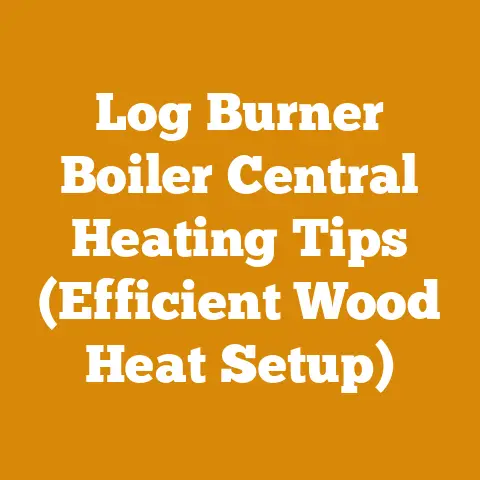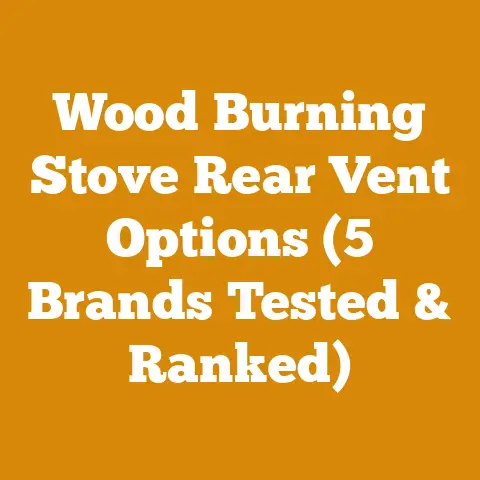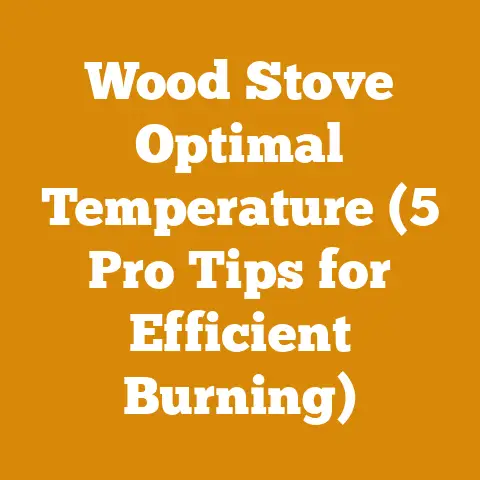Pellet Stove Exhaust Pipe Temperature (3 Key Heat Insights)
As the crisp air of autumn settles in, and the first whispers of winter begin to circulate, my thoughts, like many of yours, turn to the comforting warmth of a crackling fire. For those of us embracing the efficient heat of pellet stoves, understanding the nuances of their operation is key. Today, I’m diving deep into a critical aspect of pellet stove performance: pellet stove exhaust pipe temperature. I’ll share my insights, gleaned from years of experience in wood heating and preparation, to help you optimize your stove’s performance, ensure safety, and get the most bang for your buck – or should I say, pellet!
The global pellet stove market is booming. Reports indicate a steady climb in adoption, driven by a desire for sustainable heating solutions and rising fossil fuel costs. In North America and Europe, the use of wood pellets for heating is increasingly popular, but efficiency and safety are paramount. A study by the Pellet Fuels Institute shows that proper maintenance, including monitoring exhaust temperatures, can increase a pellet stove’s efficiency by up to 20%. That’s a significant saving, and it all starts with understanding the heat flowing through that exhaust pipe.
Pellet Stove Exhaust Pipe Temperature: 3 Key Heat Insights
Understanding your pellet stove exhaust temperature is much more than just knowing if it’s hot or cold. It’s about diagnosing potential problems, optimizing efficiency, and ensuring the safety of your home. Let’s break down the three key insights you need to know.
1. The Goldilocks Zone: What’s the Right Temperature?
Finding the “just right” temperature for your pellet stove exhaust is crucial. Too cold, and you’re wasting fuel and potentially creating creosote buildup. Too hot, and you’re losing heat up the chimney and risking damage to your stove and venting system.
- Ideal Temperature Range: Generally, you want your pellet stove exhaust temperature to be between 150°F and 400°F (66°C and 204°C). This range ensures efficient combustion and minimizes creosote formation.
- Measuring the Temperature: I use an infrared thermometer pointed at the exhaust pipe about 6-12 inches from the stove’s exhaust outlet for a quick reading. You can also install a dedicated flue thermometer for continuous monitoring.
- Factors Affecting Temperature: Several factors influence the exhaust temperature:
- Pellet Quality: Denser, drier pellets burn hotter.
- Airflow: Proper airflow is essential for complete combustion.
- Stove Settings: Higher heat settings naturally produce higher exhaust temperatures.
- Cleanliness: A clean stove and exhaust system operate more efficiently.
My Experience: I once had a customer complaining about excessive pellet consumption. After checking the exhaust temperature, it was barely reaching 100°F. The culprit? A partially blocked air intake. Cleaning the intake immediately brought the temperature back into the optimal range, saving the customer a significant amount on pellets.
2. Diagnosing Problems: Temperature as a Thermometer for Your Stove’s Health
Exhaust temperature can be a powerful diagnostic tool. Deviations from the norm often signal underlying issues that need attention.
- Low Exhaust Temperature:
- Causes:
- Poor Pellet Quality: Damp or low-quality pellets don’t burn efficiently.
- Airflow Obstruction: Blocked air intakes or a dirty combustion chamber restrict airflow.
- Draft Issues: A weak chimney draft can prevent proper combustion.
- Stove Settings: Check if the stove is set too low.
- Consequences:
- Incomplete Combustion: Wastes fuel and produces more smoke.
- Creosote Buildup: Increases the risk of chimney fires.
- Poor Heating Performance: The stove struggles to heat the room.
- Solutions:
- Switch to High-Quality Pellets: Look for pellets with low moisture content and high BTU ratings.
- Clean Air Intakes and Combustion Chamber: Regularly clean these components according to the manufacturer’s instructions.
- Check Chimney Draft: Ensure the chimney is properly sized and free of obstructions. A chimney sweep can help with this.
- Adjust Stove Settings: Increase the heat setting if necessary.
- Causes:
- High Exhaust Temperature:
- Causes:
- Excessive Airflow: Too much air can cause the pellets to burn too quickly.
- Overfeeding: The stove is feeding pellets faster than they can be burned efficiently.
- Dirty Heat Exchanger: A dirty heat exchanger reduces heat transfer, causing higher exhaust temperatures.
- Incorrect Stove Settings: The stove may be set too high for the heating demand.
- Consequences:
- Wasted Fuel: Pellets are burned too quickly, resulting in higher fuel consumption.
- Overheating: Can damage the stove components.
- Reduced Efficiency: Heat is lost up the chimney instead of being radiated into the room.
- Solutions:
- Adjust Airflow: Reduce the airflow setting if possible.
- Reduce Feed Rate: Decrease the pellet feed rate.
- Clean Heat Exchanger: Regularly clean the heat exchanger to improve heat transfer.
- Adjust Stove Settings: Lower the heat setting if appropriate.
- Causes:
Case Study: A local homeowner noticed their pellet stove exhaust was consistently running above 500°F. I inspected their stove and found the heat exchanger completely clogged with ash. After a thorough cleaning, the exhaust temperature dropped to a more reasonable 350°F, and their pellet consumption decreased by 15%. This highlights the importance of regular maintenance.
3. Safety First: Creosote and Carbon Monoxide
Exhaust temperature plays a crucial role in preventing two major safety hazards associated with pellet stoves: creosote buildup and carbon monoxide poisoning.
- Creosote Formation:
- What it is: Creosote is a highly flammable substance that forms when combustion byproducts condense in the exhaust system.
- How Temperature Affects It: Low exhaust temperatures promote creosote formation. When the flue gases cool too quickly, they condense on the chimney walls, leaving behind a sticky, tar-like residue.
- Preventing Creosote: Maintaining an adequate exhaust temperature (above 150°F) helps prevent creosote buildup. Regular chimney inspections and cleaning are also essential.
- Carbon Monoxide Poisoning:
- What it is: Carbon monoxide (CO) is a colorless, odorless, and deadly gas produced by incomplete combustion.
- How Temperature Affects It: Incomplete combustion, often caused by low exhaust temperatures and poor airflow, increases the risk of CO poisoning.
- Preventing CO Poisoning:
- Install CO Detectors: Place CO detectors on every level of your home, especially near sleeping areas.
- Maintain Proper Ventilation: Ensure the stove has adequate airflow.
- Regular Inspections: Have your stove and exhaust system inspected annually by a qualified technician.
- Proper Installation: Ensure the stove is installed according to the manufacturer’s instructions and local codes.
Warning: Never ignore signs of potential CO poisoning, such as headaches, dizziness, nausea, or flu-like symptoms. If you suspect CO poisoning, evacuate your home immediately and call emergency services.
Deeper Dive: Optimizing Pellet Stove Performance
Now that we’ve covered the key insights about exhaust temperature, let’s delve into some specific strategies for optimizing your pellet stove’s performance.
Pellet Selection: The Fuel That Feeds the Fire
The type of pellets you use significantly impacts your stove’s performance and exhaust temperature.
- Pellet Grades:
- Premium: Low ash content (less than 1%), high BTU rating, and consistent size.
- Standard: Higher ash content (1-3%), lower BTU rating, and potentially more fines (small particles).
- Utility: Highest ash content (over 3%), lowest BTU rating, and often inconsistent size.
- Moisture Content: Aim for pellets with a moisture content of 8% or less. Drier pellets burn hotter and cleaner.
- Ash Content: Lower ash content means less frequent cleaning of the stove and exhaust system.
- Species of Wood: Hardwood pellets generally burn hotter and longer than softwood pellets.
- Storage: Store pellets in a dry, sheltered location to prevent moisture absorption.
My Recommendation: I always recommend using premium pellets. While they may cost slightly more upfront, the improved efficiency, reduced maintenance, and cleaner burning make them well worth the investment in the long run. I’ve found that using premium pellets can increase the time between cleanings by as much as 50%.
Airflow Management: The Breath of Life for Your Stove
Proper airflow is essential for complete combustion and optimal exhaust temperature.
- Air Intake: Ensure the air intake is free of obstructions, such as dust, pet hair, or debris.
- Combustion Chamber: Regularly clean the combustion chamber to remove ash and clinkers (hard, fused ash deposits).
- Exhaust Vent: Inspect the exhaust vent for blockages, such as bird nests or creosote buildup.
- Draft: A strong chimney draft is crucial for proper combustion. If you suspect a draft issue, consult a chimney sweep.
- Adjustable Airflow Settings: Some pellet stoves have adjustable airflow settings. Experiment with different settings to find the optimal balance between heat output and fuel efficiency.
Tip: A leaf blower can be a handy tool for cleaning out the exhaust vent. Just be sure to disconnect the stove from the power source first!
Cleaning and Maintenance: The Key to Longevity
Regular cleaning and maintenance are essential for keeping your pellet stove running efficiently and safely.
- Daily: Empty the ash pan and inspect the combustion chamber.
- Weekly: Clean the combustion chamber, heat exchanger, and air intakes.
- Monthly: Inspect the exhaust vent and clean if necessary.
- Annually: Have the stove and exhaust system professionally inspected and cleaned.
Pro Tip: Keep a log of your cleaning and maintenance activities. This will help you track the performance of your stove and identify potential problems early on.
Troubleshooting Common Issues
Even with proper maintenance, you may encounter occasional issues with your pellet stove. Here are some common problems and their solutions:
- Stove Won’t Start:
- Possible Causes: Empty hopper, faulty igniter, blocked air intake.
- Solutions: Fill the hopper, replace the igniter, clean the air intake.
- Stove Smokes Excessively:
- Possible Causes: Poor pellet quality, blocked air intake, incomplete combustion.
- Solutions: Switch to high-quality pellets, clean the air intake, adjust airflow settings.
- Stove Overheats:
- Possible Causes: Excessive airflow, overfeeding, dirty heat exchanger.
- Solutions: Adjust airflow settings, reduce feed rate, clean the heat exchanger.
- Stove Produces a Lot of Ash:
- Possible Causes: Low-quality pellets, incomplete combustion.
- Solutions: Switch to high-quality pellets, adjust airflow settings.
Remember: Always consult the manufacturer’s instructions for specific troubleshooting guidance.
Costs and Budgeting: Planning for the Long Haul
Investing in a pellet stove is a long-term commitment. It’s important to factor in all the associated costs, including:
- Stove Purchase: Pellet stoves range in price from $1,500 to $5,000 or more, depending on size, features, and brand.
- Installation: Professional installation can cost several hundred dollars.
- Pellets: The cost of pellets varies depending on quality, availability, and location.
- Maintenance: Factor in the cost of cleaning supplies, replacement parts, and professional inspections.
- Electricity: Pellet stoves require electricity to operate the auger, fans, and controls.
Budgeting Tip: Create a spreadsheet to track your pellet stove expenses. This will help you stay on budget and identify potential cost savings.
- Monitor Your Exhaust Temperature: Invest in an infrared thermometer or flue thermometer to track your stove’s exhaust temperature.
- Inspect Your Stove and Exhaust System: Regularly inspect your stove and exhaust system for signs of problems.
- Clean Your Stove Regularly: Follow the manufacturer’s instructions for cleaning and maintenance.
- Consult a Professional: If you have any concerns about your pellet stove’s performance, consult a qualified technician.
Additional Resources:
- Pellet Fuels Institute: https://www.pelletheat.org/
- Your Local Chimney Sweep: Find a certified chimney sweep in your area.
- Pellet Stove Manufacturers: Consult the manufacturer’s website for specific information about your stove model.
In conclusion, understanding pellet stove exhaust pipe temperature is essential for optimizing performance, ensuring safety, and maximizing the lifespan of your stove. By following the tips and strategies outlined in this guide, you can enjoy the warmth and efficiency of your pellet stove for years to come. Now, go forth and conquer the cold!






